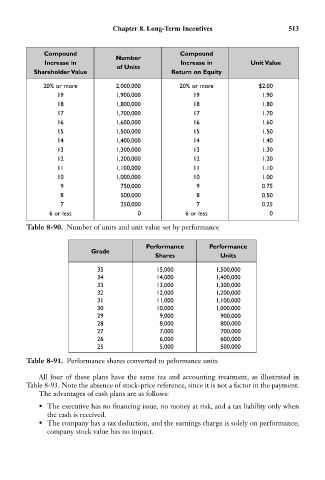Page 527 - Bruce Ellig - The Complete Guide to Executive Compensation (2007)
P. 527
Chapter 8. Long-Term Incentives 513
Compound Compound
Number
Increase in Increase in Unit Value
of Units
Shareholder Value Return on Equity
20% or more 2,000,000 20% or more $2.00
19 1,900,000 19 1.90
18 1,800,000 18 1.80
17 1,700,000 17 1.70
16 1,600,000 16 1.60
15 1,500,000 15 1.50
14 1,400,000 14 1.40
13 1,300,000 13 1.30
12 1,200,000 12 1.20
11 1,100,000 11 1.10
10 1,000,000 10 1.00
9 750,000 9 0.75
8 500,000 8 0.50
7 250,000 7 0.25
6 or less 0 6 or less 0
Table 8-90. Number of units and unit value set by performance
Performance Performance
Grade
Shares Units
35 15,000 1,500,000
34 14,000 1,400,000
33 13,000 1,300,000
32 12,000 1,200,000
31 11,000 1,100,000
30 10,000 1,000,000
29 9,000 900,000
28 8,000 800,000
27 7,000 700,000
26 6,000 600,000
25 5,000 500,000
Table 8-91. Performance shares converted to peformance units
All four of these plans have the same tax and accounting treatment, as illustrated in
Table 8-93. Note the absence of stock-price reference, since it is not a factor in the payment.
The advantages of cash plans are as follows:
• The executive has no financing issue, no money at risk, and a tax liability only when
the cash is received.
• The company has a tax deduction, and the earnings charge is solely on performance;
company stock value has no impact.

